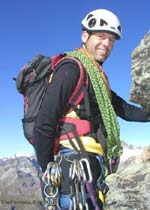Via Ferrata: What parents should know!

Nonetheless, where do we set the limitis for our children, how far is it possible to go, how can we go up via ferratas safely and especially with respect?
It is with great pleasure that we welcome Jérôme Nanchen to our publication. Jérôme is an eminent sports psychologist and he coaches a lot of athletes. Jérôme also has a passion for the mountains and is a nature lover.
He lives in Switzerland with his three adorable children and loving wife. Make the most of his experience and wisdom!
Some generalities
A via ferrata is not something trivial and even less so for children; we have a tendancy to downplay Via Ferratas and minimize their difficulty under the cover of security and easiness...
The grade AD= AD for adults, it's not the same for a child. Try it with a range of motion reduced by 30 to 50%, less motor experience and less familiarity with the void; all the perceived dimensions will be on a whole other level for children.
Only climbing technique, which is less demanding, and holds (bigger and more available) make things easier for kids; the other parameters remain.
Technique
Plan to have special webbing for children; those for adults will not sufficiently absorb the shock and can lead to serious injury in the event of a fall.
Plan to train and repeat the manipulations of caribiners and also the belay rope when still on the ground (see the next point).
Rope: a piece of rope to belay from above for the adult, pass the rope through the "pig's tail" anchors
Rest: carabiner on the belay loop, in order to secure oneself and be able to rest in case of fatigue
Pratice
Choose a Via Ferrata that has an escape route on the way up; the self-assurance and certainty of the beginning may not last!
Rest: take more frequent breaks, drink and eat enough
Time: multiply the given time by 1.5 to respect the child's rhythm and characteristics
Mental
Perception: the perception of events by children is not at all the same as for adults; remember how a harmless section today would have seemed huge when you were 7 years old...
Children have amplified emotions, sometimes amplifying emotions, and risk being submerged by them
Children are not miniature adults, even more so from the point of view of mental capacities; a child has his own capacities which must absolutely be taken into account; adultomorphism is a bait, this also applies to Via Ferratas; children are beginners at everything, whereas adults can transfer their experiences from one domain to another
Via ferratas allow children to progress in the proximal zone of their development, that is to say that we can push them a little, but all the while taking into account their current capacities; do not rush them or suggest that they skip steps prematurely; this is important in the areas of concentration skills (more limited as time goes on), controlling emotions (less rational), and controlling stress (less differentiated)
Be on the look out for signs of stress: complaints, tenseness, freezing up, cries, ...; signs of their current limits
A child's motivations for doing a Via Ferrata can be intrinsic (they come from himself, from his desire, from the joy he has in facing a cliff) and, in this case, strong and rarely called into question.
They can also be extrinsin (to please the parents, for their pride, to do what the parents do, to fulfill some expectations). In this case they may not necessarily be sufficient to call upon all of the child's capacities and may crumble when the first difficulty is encountered.
Conclusion
For the child it is important to:
A) learn to have confidence and feel in control, and not be afraid
B) be in the moment and enjoy the movements, the company, the mastery of the skill; and to not be obsessively fearing the next difficulty
C) experience the void and its demands with respect, in a positive light that the child will ask to experience again; the conclusive "never again" after a via ferrata outing does not augur well for the continuation of the Via Ferrata experience.
For the parent-child relationship:
We can say that it is often tinged by the parent's ambition, more or less sound and aware, that their children make up for what they themselves failed at doing for their own bosses; this effect of transferring expectations from one generation to the next can be the source of significant wrongdoings.
The desire that certain parents have for their children to do things out of the ordinary, in order to satisfy their own ego and wave high the family colors, makes these parents go to extremes that have little to do with their child's reality.
By Jérôme Nanchen, for ViaFerrata.com
To contact Jérôme
